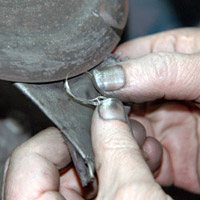Masters At Work - Ring Resizing and Finishing
Resing a gold or platinum ring is an art form. While many jewelers are quite capable,
only a master jeweler produces a flawless creation that is indistinguishable from a perfecly cast ring.
The Torch
The first step to resizing a ring (especially when decreasing the ring size which is discussed here),
is to properly prepare the ring. Using a jeweler's saw, the bottom of the ring shank is cut to remove
excess shank metal. Two open ends are thus formed. A file is then applied to smooth these ends. The
jeweler now confirms that the shank is properly resized. A small sliver of the original metal is cut
and will be added to the main shank to merge the open ends. When the ring and additional piece of metal
are ready, they are carefully soldered together at high temperature with an acetylene torch (pictured
in Figures 1 and 2). The ring is checked on a mandrel to ensure that its circumference is true and round.
If not perfectly round, it is carefully rounded using a rubberized mallet.
 Figure 1:
Figure 1: The soldering
process. In the hands of a
Gemnation Master Jeweler, the
acetylene torch is applied to
rejoin the resized shank.
 Figure 2:
Figure 2: During the soldering
process, there is intense heat
build-up. The jeweler must be
exceptionally careful not to melt
the ring.
Pre-polishing
The jeweler hands the ring to the polisher. Using a rubberized mounted silicon wheel, spinning at up to
21,000 rpm and containing an abrasive compound, the polisher creates a smoothed metal finish (Figure 3).
It cuts and smoothes the metals surface and removes visible traces of sanding, filing, or other abrasive
procedures. A large polishing brush (Figure 4) is then applied to pre-polish the outside of the ring.
A smaller "dental" brush (Figure 5) cleans hard-to-reach inside areas and crevices. Additional tools
like a cross-sander may also be applied.
 Figure 3:
Figure 3: The rubber wheel is
used in the pre-polishing
process.
 Figure 4:
Figure 4: A coarse polishing
brush is used to pre-polish
the outside of the ring.
 Figure 5:
Figure 5: A smaller brush is
used to pre-polish the inside
of the ring.
Lapping
A lapping wheel (Figure 6) is used carefully to ensure that the surface remains true and flat.
 Figure 6:
Figure 6: Lapping ensures a
true and even finish.
Polishing
The polisher continues to work the outside surface of the ring with an 800 compound buffing brush
(Figure 7). Following each polishing step, the ring is cleaned in the ultrasonic cleaner (Figure 8),
then steam cleaned (Figure 9), and then progressed to the next compound. Finer and finer compounds
will be used, including 4,000 compound, 6,000 compound and finally 8,000 compound.
 Figure 7:
Figure 7: Buffing progresses
from one compound to another,
eachprogressively finer.
 Figure 8:
Figure 8: The ultrasonic
detergent bath cleans the ring
using ultra-high sound
frequencies.
 Figure 9:
Figure 9: Any remaining dirt is
removed by steam-cleaning.
When the polisher is certain the ring is free of any porosity, dirt, scratches, bumps, or any other
surface imperfections, the polishing process is concluded and a final ultrasonic cleaning, steam-cleaning
and electro-cleaning (Figure 10) are conducted. The ring, whether platinum or gold will now possess a
striking mirror-like luster. Before the ring is sent to the shipping department, it is given to the
quality controller who follows a ten point checklist to confirm, among other things, proper diamond
or gemstone seating and pronging (if appropriate), pristine metal finishing, and appropriate hallmarking.
The finished ring is now handed to the packing and shipping department.
 Figure 10:
Figure 10: Electro-cleaning is
the final cleaning step.










